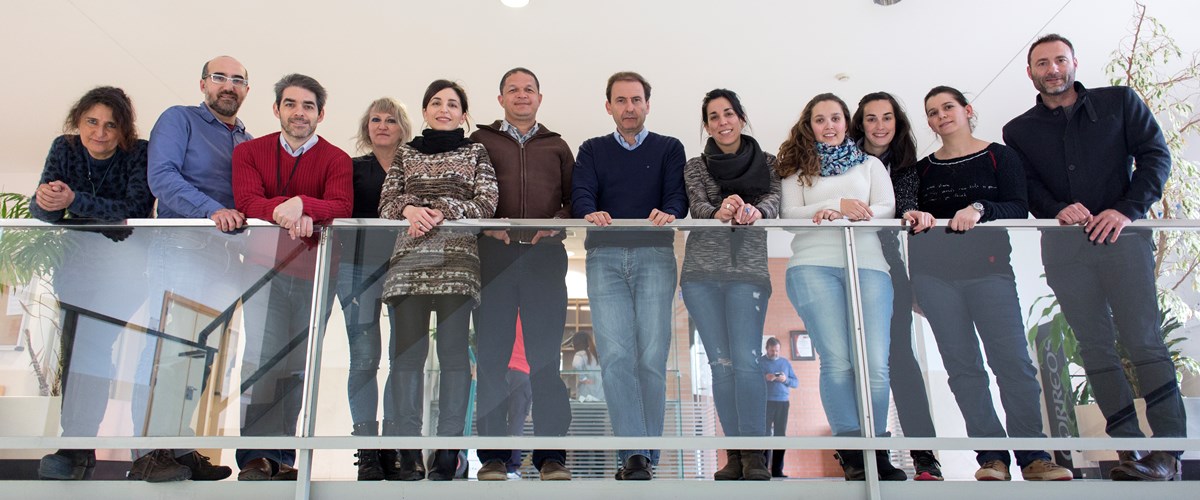Cellular Diagnostics Service

Cytometry Service
Centro de Investigación del Cáncer (CSIC-USAL).
Campus Universitario Miguel de Unamuno s/n E-37007 Salamanca (Spain)
Personnel
The Cytometry Service (SGC) is a common research platform of open use to all members of the Institute (Cancer Research Centre) as well as to other external research and clinical groups. It is aimed at supporting research and education in cytometry. The most relevant activities include cell analysis and sorting for research purposes with more than 50 different techniques being currently set up and available in the area of immunophenotyping, cell cycle analysis, apoptosis, drug resistance and screening, quantification of phosphorylated proteins and their associated intracellular signalling pathways, among others. In addition, it provides tests to support the diagnosis of cancer acting as a common platform for the immunophenotypic diagnosis of leukemias and lymphomas for the Spanish RTICC from the Instituto de Salud Carlos III. In parallel, at the SGC there are several ongoing technologically oriented research projects.
Finally, the SGC has an important role in education in Cytometry with more than 35 researches from all over the world being trained during the last year, and more than 350 in the last 15 years.
ISO Certifications: The SGC is certified with the ISO-9001:2000, applied to «Molecular, Genetic and immunophenotypic studies
to support the diagnosis and monitoring of haematological malignancies, using flow cytometry, FISH and molecular biology» since the 3rd of August 2007.
In this Facility we provide complete services for:
-
Screening of monoclonal gammapathy.
-
Screening of lymphocytosis or suspect of mature T-cell lymphoid neoplasms in peripheral blood, cerebrospinal fluid, bone marrow, lymph node or other tissue.
-
Immunophenotypic characterization of Mature B-cell lymphoid neoplasms y Waldenstrom’s macroglobulinemia.
-
Screening of clonality of mature alfa-beta T-and gammadelta T cells lymphoid neoplasms by flow cytometry.
-
Immunophenotypic characterization of mature T and NKcell neoplasm.
-
Screening of acute leukemias.
-
Immunophenotypic characterization of myeloid acute leukemias and myelodysplastic syndromes.
-
Screening and immunophenotypic characterization of B-precursor lymphoblastic leukaemia and T-cell lineage acute lymphoblastic leukaemia.
-
Immunophenotypic characterization of chronic myeloid leukaemia.
-
Detection of minimal residual diseases in acute and chronic leukaemias studied at diagnosis in our service.
-
Detection of minimal residual diseases in acute and chronic leukaemias and acute myeloid leukaemias.
-
Screening of mastocytosis.
-
Immunophenotypic screening of histiocytosis and Reed Stenberg cells.
-
Screening of primary immunodeficiency and paroxymal nocturnal hemoglobinuria.
-
Immunophenotypic characterization of the platelets.
-
Detection of antiplatelet autoantibodies in platelets and plasma.
-
Quantitation of CD34+ cells.
-
Control of leucodepletion.
-
Antigenic quantitation.
-
Spherocytosis.
-
DNA quantitation in mature and immature B cell, plasma cells and epithelial cells.
-
Evaluation of Zap70.
-
Evaluation of viability by DRAQ5 or Dye Cycle.
-
DNA quantitation with phenotype and DRAQ5 or Dye Cycle in myeloid leukemia or myelodisplastic syndromes.
-
Evaluation of each individual antigen.
-
Study of the presence of one, two or three genetic abnormalities by in situ hybridization.
-
Study of the presence of prognostic genetic abnormalities in B-cell chronic lymphocytic leukemia.
-
Evaluation of each individual genetic abnormality by in situ hybridization.
-
Sample purification for molecular biology techniques.
-
Evaluation of CKIT mutations by molecular biology.
-
Humara PCR test for one cell population.
-
Sorting of cell populations.
-
Acquisition and analysis at the flow cytometer.
-
Immunobead protein assays.
Equipment
- Cytometer Analyzer FACScanto II (BDB) for analysis in 8 fluorescence.
- 2 Cytometer Analyzer FACScalibur I (BDB) for analysis in 4 fluorescence.
- 1 Cytometer LSR-Fortessa X20 (BDB) for analysis in 13 fluorescence.
- Fluorescence microscopies.
- Other equipment: centrifuges, refrigerators, freezers, bathrooms…

